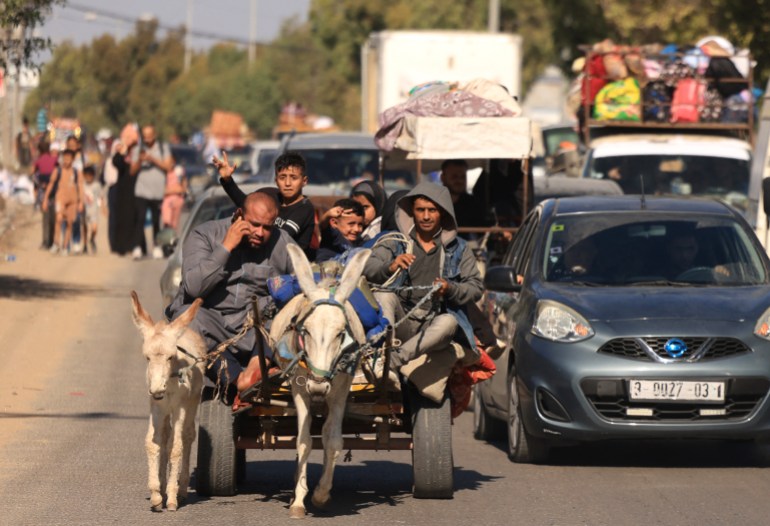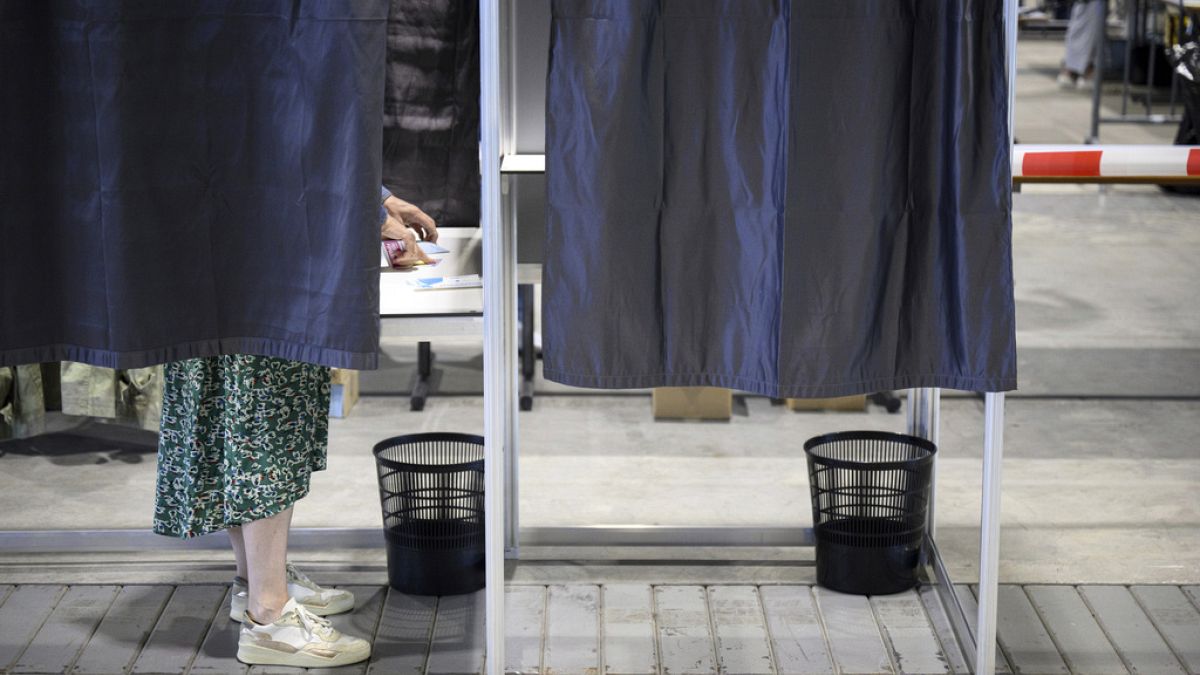World
‘Nowhere safe to go’: Confusion, fear after Israel’s warning to evacuate

Twenty-one-year-old Mohammed Elewa has barely gotten any sleep this past week in the Gaza Strip.
The sound of Israeli bombs and Palestinian ambulance sirens is a constant background noise as Israel pounds the Strip in revenge for a surprise attack by Hamas on Israel on October 7.
On Friday morning, he woke up to the news that the Israeli military had issued evacuation orders for more than a million people in the northern Gaza Strip – nearly half of a total of 2.3 million residents.
The directive comes ahead of a feared ground invasion, but Elewa did not feel there was any point in leaving.
“There’s nowhere safe to go. Where am I supposed to go?” asks Elewa on the phone from his home.
He is one of many in Gaza City who say they have to stay because they cannot make their way to the south.
‘There was no space’
In a press statement, the Hamas leadership called the Israeli order “psychological warfare”.
“The current developments in Gaza represent an extraordinarily audacious and brutal endeavour to forcibly remove the Palestinian people from their land,” said Izzat al-Risheq, a member of the Hamas political bureau.
Elewa ended up staying in Shujayea with some cousins and sisters, while others in his family went to the schools being used as shelters or to relatives in the south.
More than 270,000 displaced people have sought refuge in 88 schools run by UNRWA, the UN agency providing assistance to Palestinian refugees, in the northern Gaza Strip.
But the overcrowding was such that, in some cases, “there were already 50 people to a room”, the paracyclist, whose leg was amputated when he was injured in the Gaza border protests five years ago, said.
“I wanted to go with them [my family], but there was no space,” Elewa, said.
“[Now], they’re asking everyone to leave, but there’s literally nowhere to go. They’re just telling us to go stand in the street,” he adds, a mix of panic and anger in his voice.
A loud explosion sounds on the other end of the call and the phone connection is cut.
At least 1,300 people were killed in the attack on Israel, while at least 1,799 Palestinians including 583 children have been killed in Israel’s bombardment of Gaza.

Death sentence for the vulnerable
The United Nations has called on Israel to rescind the evacuation order, saying the movement of people on that scale is “impossible” without dire humanitarian consequences.
Thousands of people were seen heading south on vehicles and on foot on Friday, clutching their children and meagre belongings.
But many cannot leave – like the many patients in Gaza’s overstretched hospitals.
“[It is impossible] to evacuate Al-Shifa hospital,” Dr Yusuf Abu al-Rish, Gaza’s deputy health minister, said in a message to reporters, referring to the Gaza Strip’s largest hospital, which is stretched well over its 500-bed capacity.
“All the other hospitals are full of injured patients,” Abu al-Rish added.
“Most cases are not stable enough to be transported,” he said. “Even if there is a decision [to evacuate], it’s not applicable at all.”
Tarik Jasarevic, spokesperson for the World Health Organization in Geneva, said it would be impossible to evacuate vulnerable hospital patients and such a move would be a death sentence for many.

‘No one can speak’
“I saw a lot of people earlier today escaping on trucks, donkeys, cars,” 33-year-old journalist Mohammed Abu Safia said from Gaza City. “I saw up to 10 people in one car.”
Abu Safia, who has already lost many members of his extended family in the past week, had come to Gaza City from Beit Lahiya in the far north of Gaza after the Israeli order.
He was sheltering in a church-run school with his young family of four.
“If you look at the people, you can see fear in their eyes, no one can speak,” said Abu Safia. “If I try to interview someone, they start arguing with me. No one can think straight.”
‘World leaders should speak up’
“I watched those videos [of people fleeing] today and I cried,” 36-year-old Wafaa al-Qudra told Al Jazeera.
“[Israel] knows we are in a state of war and there are no means of transport,” al-Qudra added, “Are they just trying to humiliate people?”
“This order does not alter Israel’s obligations in military operations to never target civilians and take all the measures it can to minimise harm to them,” said Clive Baldwin, senior legal adviser at Human Rights Watch.
“The roads are rubble, fuel is scarce, and the main hospital is in the evacuation zone,” he added. “World leaders should speak up now before it is too late.”
“The south is being bombed,” al-Qudra said, explaining why she decided to not try to evacuate. “My family lives there and they say the bombing didn’t stop for a minute.”
Meanwhile, Elewa, the paracyclist, gets back in touch with news he has survived the earlier bombing and is preparing for another frightening night under Israeli bombardment.
“There’s absolutely no sleep that’s happening at all,” he says. “Everyone’s just on edge, just waiting.”

World
Israel moves towards ceasefire deal with Hezbollah: reports

Israel is reportedly moving towards a ceasefire agreement with Hezbollah in Lebanon after nearly a year of fighting escalated into an all-out war in September.
Israeli media outlets including YNET and Haaretz have reported that Israel has tentatively agreed to a U.S.-backed proposal for a ceasefire. No final deal has been reached, according to the reports.
Journalists take pictures of a building hit direct by a rocket fired from Lebanon in Haifa, Israel, Sunday Nov. 24, 2024. (AP Photo/Francisco Seco)
Lebanon and the militia group Hezbollah reportedly agreed to the deal last week but both sides need to give the final okay before it can materialize.
The reported ceasefire deal comes after Hezbollah launched one of its largest rocket attacks on Israel in exchange for Israeli forces striking Hezbollah command centers in Beirut.
This is a developing story. Check back for updates.
World
Yamandu Orsi wins Uruguay’s run-off presidential election

Yamandu Orsi, the candidate for the left-wing Broad Front coalition, is projected to emerge victorious in Uruguay’s run-off election for the presidency.
He bested Alvaro Delgado of the ruling National Party to win the tightly fought race, though public opinion polls showed the two candidates in a dead heat in the lead-up to Sunday’s vote.
Orsi’s supporters took to the streets in the capital of Montevideo, as the official results started to show the former mayor and history teacher surging ahead.
Many waved the party banner: a red, blue and white striped flag with the initials FA for “Frente Amplio”, which translates to “Broad Front”.
“Joy will return for the majority,” the coalition posted on social media as Orsi approached victory. “Cheers, people of Uruguay.”
Orsi’s win restores the Broad Front to power in the small South American country, sandwiched on the Atlantic coast between Brazil and Argentina.
For 15 years, from 2005 to 2020, the Broad Front had held Uruguay’s executive office, with the presidencies of Jose Mujica and Tabare Vazquez, the latter of whom won two non-consecutive, five-year terms.
But that winning streak came to an end in the 2019 election, with the victory of current President Luis Lacalle Pou, who led a coalition of right-leaning parties.
Under Uruguay law, however, a president cannot run for consecutive terms. Lacalle Pou was therefore not a candidate in the 2024 race.
Running in his stead was Delgado, a former veterinarian and Congress member who served as a political appointee in Lacalle Pou’s government from 2020 to 2023.
Even before the official results were announced on Sunday, Delgado had conceded, acknowledging Orsi’s victory was imminent.
“Today, the Uruguayans have defined who will hold the presidency of the republic. And I want to send here, with all these actors of the coalition, a big hug and a greeting to Yamandu Orsi,” Delgado said in a speech as he clutched a large Uruguayan flag in his hand.
He called on his supporters to “respect the sovereign decisions” of the electorate, while striking a note of defiance.
“It’s one thing to lose an election, and another to be defeated. We are not defeated,” he said, pledging that his right-wing coalition was “here to stay”.
The outgoing president, Lacalle Pou, also reached out to Orsi to acknowledge the Broad Front’s victory.
“I called [Yamandu Orsi] to congratulate him as president-elect of our country and to put myself at his service and begin the transition as soon as I deem it pertinent,” Lacalle Pou wrote on social media.

Orsi had been considered the frontrunner in the lead-up to the first round of the elections.
Originally from Canelones, a coastal regional in the south of Uruguay, Orsi began his career locally as a history teacher, activist and secretary-general of the department’s government. In 2015, he successfully ran to be mayor of Canelones and won re-election in 2020.
In the 2024 presidential race, Orsi – like virtually all the candidates on the campaign trail – pledged to bolster Uruguay’s economy. He called for salary increases, particularly for low-wage workers, to grow their “purchasing power”.
He also called for greater early childhood education and employment programmes for young adults. According to a United Nations report earlier this year, nearly 25 percent of Uruguay’s children live in poverty.
But the economy was not the only issue at the forefront of voters’ minds. In a June survey from the communications firm Nomade, the largest share of respondents – 29 percent – identified “insecurity” as Uruguay’s “principal problem”.
That dwarfed the second-highest ranked topic: “Unemployment” was only picked by 15 percent of respondents.
As part of his platform, Orsi pledged to increase the police force and strengthen Uruguay’s borders, including through the installation of more security cameras.
As he campaigned, Orsi enjoyed the support of former President Mujica, a former rebel fighter who survived torture under Uruguay’s military dictatorship in the 1970s and ’80s.
Mujica remains a popular figure on Uruguay’s left, best known for his humble living arrangements that once earned him the moniker of the “world’s poorest president”.

In the first round of voting, on October 27, Orsi came out on top, with 44 percent of the vote to Delgado’s 27 percent. But his total was far short of the 50 percent he needed to win the election outright, thereby triggering a run-off.
The race got tighter from there forward. Only two candidates progressed to the run-off – Delgado and Orsi – and Delgado picked up support from voters who had backed former Colorado Party candidate Andres Ojeda, a fellow conservative who was knocked out in the first round.
Nevertheless, Orsi quickly pulled ahead after the polls closed for the run-off election on Sunday.
“The horizon is brightening,” Orsi said in his victory speech. “The country of freedom, equality and also fraternity triumphs once again.”
World
Cinematography Work at Camerimage Festival ‘Radically Different,’ Jury Members Say

Jurors at the EnergaCamerimage cinematography fest say the Golden Frog main competition films have been remarkably varied and inspiring in the event’s 32nd edition.
The 12 competing films “were radically different from each other,” said “Barbie” and “Killers of the Flower Moon” cinematographer Rodrigo Prieto, whose directorial debut, “Pedro Paramo,” is also screening at the fest. “I enjoyed that.”
The varied styles, approaches and storytellers, he added, defied easy categorization. “Happily, I didn’t notice trends, which I have noticed sometimes in the past in some festivals.”
Juror Anthony Dod Mantle, who won Golden Frogs in 2008 for his lensing of “Slumdog Millionaire” and in 2016 for “Snowden,” said, “I’ve been to this festival before and the overall collection of films and categories, I felt, was even wider. I feel slight absence of certain films from other ethnic backgrounds. They were different, these films, but they could be far more different.”
Greater diversity and inclusion in cinematography has justly been a hot topic this year at Camerimage, he added. “It’s good we embrace that, celebrate it here, because not many festivals do that.”
Dod Mantle described the current state of cinematography, based on what the jury’s seen this week, as “openly variable and that’s why we praise some films rather than others because they challenge convention.”
He also described the industry as “in a bit of a pickle,” adding, “We know that. We have to applaud ourselves and embrace and encourage every single essence of, molecule of, exploration and challenging cinema.”
Juror Lukasz Zal, who filmed “The Zone of Interest” and “Cold War,” said “I feel really inspired. I feel this kind of positive envy when you just see something which you admire, and love – cinema is still in good condition.”
And, he added, “I’m becoming hopeful that, OK, there’s still a lot to discover. For this, I really love Camerimage. When I was here, when I was a student, I was always coming back home after festival, with this feeling, kind of eager to work, to prepare and to just be really open and be full of ideas.”
Spending time here again as a top professional in his field, Zal said, “I feel again like a student.”
Juror Cate Blanchett said it’s clear cinematography has no crisis of creativity currently.
Instead, there’s a different issue: “The pickle is how one gets access and is able to see these films in the way that they’re intended to be seen.”
Technology advances in the field are also helping storytelling onscreen evolve, she added, rather than distracting from it. “Sometimes you can see there’s been huge technical advances made, or there’s been big innovations, and they haven’t yet been integrated into the stories that they’re being applied to. Whereas I thought there were so many films here that have really integrated the technology and in a completely adventurous and inventive way that was not pretentious. It was very interwoven and enmeshed with the performances and the stories.”
Jury duty at Camerimage is rewarding, said Dod Mantle, because the Golden Frog award can often help promising cinematographers break through to booming careers.
He described the potential effect of the award as “enormous.”
“The first time I came here, in competition,” he recalled, “it illustrated for me the jury was embracing cinema, celebrating something different and challenging.”
Cinematographers are keenly aware of the judgment of their peers, Dod Mantle added. “You feel quite vulnerable here. I’ve seen cinematographers leave the festival and go spend the weekend in Krakow and come back. The frog, ultimately is a beautiful thing celebrating our colleagues’ work.”
Juror Anna Higgs, a producer and columnist who works closely with BAFTA, said, “I think we should normalize cinematographers getting asked for their autographs – the fact that this frog is the idolized thing here.”
Blanchett added, “It’s very rare that you go to a festival where every single person in the auditorium sits right through the credit roll to the very end.” She noted “the respect that is shown to every single crewmember.”
Prieto recalled the impact of his own Golden Frog cinematography win in 2000 for “Amores Perros” fondly. “I do cherish that frog. It’s wonderful to get a frog, but more than anything, it’s a place where cinematography is the focus and is celebrated, and to share that obsession with so many people, and the energy of that, is really wonderful.”
Zal had a similar career boost, he said, after winning for lensing “Ida” by Pawel Pawlikowski in 2013. “That’s really the moment when somehow my career changed. I was always dreaming while having student films here. And it was beautiful to get an award from colleagues and being here and being among amazing cinematographers.
“I was put in competition with the people who I admire. Even now, sitting with Rodrigo, who for me was a huge inspiration. I was shooting my films in school inspired by ‘Amores Perros.’ Now we’re sitting together on the jury. That’s amazing, that’s beautiful.”
Blanchett described the close proximity of students and top international lensers as a unique strength of Camerimage, praising “the mentorship that goes on, how you’ll champion the works of other people.”
“I think that’s why it’s so vitally important that there’s an increased level of female participation. Because of the networking and mentorship opportunities and championing the work. The conversations and the opportunities that arise from those conversations are really important.”
Oscar-winning costume designer Sandy Powell (“Shakespeare in Love,” “The Aviator” and “The Young Victoria”) and cinematographer and documentary filmmaker Jolanta Dylewska also served on the Camerimage jury, calling earlier this week for greater diversity and inclusion in the industry.
-

 Business1 week ago
Business1 week agoColumn: Molly White's message for journalists going freelance — be ready for the pitfalls
-

 Science5 days ago
Science5 days agoTrump nominates Dr. Oz to head Medicare and Medicaid and help take on 'illness industrial complex'
-

 Politics1 week ago
Politics1 week agoTrump taps FCC member Brendan Carr to lead agency: 'Warrior for Free Speech'
-
/cdn.vox-cdn.com/uploads/chorus_asset/file/25739950/247386_Elon_Musk_Open_AI_CVirginia.jpg)
/cdn.vox-cdn.com/uploads/chorus_asset/file/25739950/247386_Elon_Musk_Open_AI_CVirginia.jpg) Technology6 days ago
Technology6 days agoInside Elon Musk’s messy breakup with OpenAI
-

 Lifestyle1 week ago
Lifestyle1 week agoSome in the U.S. farm industry are alarmed by Trump's embrace of RFK Jr. and tariffs
-

 World1 week ago
World1 week agoProtesters in Slovakia rally against Robert Fico’s populist government
-

 News7 days ago
News7 days agoThey disagree about a lot, but these singers figure out how to stay in harmony
-

 News1 week ago
News1 week agoGaetz-gate: Navigating the President-elect's most baffling Cabinet pick





/cdn.vox-cdn.com/uploads/chorus_asset/file/25753264/Screenshot_2024_11_24_at_4.53.29_PM.png)










